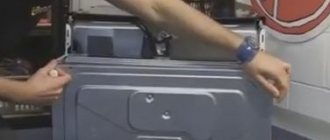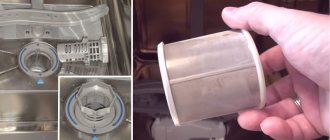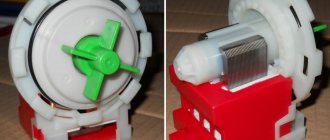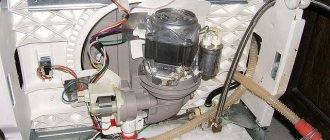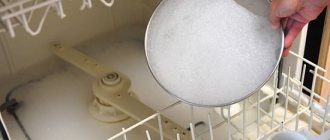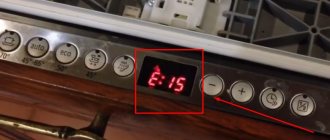All about the dishwasher valve
A dishwasher makes the life of a modern housewife much easier, saving time and water. Comparing the amount of liquid spent in the process of manually washing dishes and using an innovative unit, many come to the conclusion about the benefits of a technical invention. The cost of purchasing it will pay off in about six months.
Choosing a valve for a dishwasher
One of the important elements in a dishwasher are the valves. They are needed in order to create the necessary conditions for the unhindered flow of water into the device and its timely outflow. The liquid is supplied using a fill hose and exits through the drain. Based on the type of structure, the following dishwasher valves are distinguished:
Depending on the model of the machine, be it Bosch, Electrolux, Zanussi, Ariston, Beko, it has a set of several valves installed; failure of any valve will result in the inability to use the device in one of the modes.
The meaning and design of the pressure switch
Since the operation of the parts in the machine is controlled by the main module, it needs to send a signal to stop the intake of water, as well as close the inlet valve. But how does the module know that the accumulated volume is enough? Let's figure out what the purpose is and how the pressure switch works in a washing machine. This element controls the amount of water collected in the SMA. Each separate mode - washing or rinsing - requires a different amount of water.
Let's consider the principle of operation of the pressure switch in a washing machine. This is a round part that has a plastic body; connected to it are: a hose through which pressure passes, and wiring. Inside the relay housing there is a thin membrane and a switch. The pressure in the tank depends on the amount of water collected. Air under pressure passes through the hose, acts on the membrane, and it bends, closing the switch. Using wiring, the module receives a signal to stop water intake. These are the design and operation of the pressure switch.
Many users do not know where the pressure switch is located in the washing machine. Some people think it should be located inside the tank. In fact, the device is located at the top of the SM body, near the side wall.
Solenoid valve function
The small part plays an important role: it controls the dishwashing process and is responsible for the timely cessation of water flow when the device turns off or this is provided for by the selected program. The part also ensures that the process of draining water begins when the engine is running.
There are two types of dishwasher solenoid valve:
- active;
- responsible for the uninterrupted operation of the device, are triggered in critical situations or at moments specified in the program.
The second type of dishwasher valve is located at the end of the hose through which the liquid is supplied. It can withstand significant loads and pressure drops in the water supply system. The operating valve opens when the machine engine starts. If the device is disconnected from the power supply, there is no voltage.
Prevention measures
In order not to encounter the problem of noise during the spinning process of the Indesit washing machine, you need to remember the following preventive measures:
- When stowing items, be sure to check the pockets of items and not stow underwear with poorly sewn buttons, decor, etc.
- The search for the source of the problem should begin with simple nodes, gradually moving to complex ones.
- If extraneous sounds appear in the “spin” mode, it is necessary to organize diagnostics and establish the cause of the problem.
- It is advisable to start the machine with optimal load of laundry. It is better to avoid overloading and underloading.
- The service life of a household appliance without breakdowns largely depends on the correct installation and connection of communications.
You should not even partially open the washing machine if the device is under warranty.
A lot of important and useful information about repairing Indesit washing machines is presented in this section.
Features of the water fill valve
This part, if it fails, cannot be repaired - only replacement will solve the problem. The dishwasher fill valve regulates the amount of liquid entering the device in accordance with the set washing program. If the engine is running but no water flows, you should also check the solenoid valve (in Bosch, Beko and other models). In the photo you can see what it looks like.
The dishwasher water supply valve is responsible for the smooth flow of liquid into the dishwasher tank. Depending on the parameters of the model and its power rating, several parts of this type can be installed in the device. The dishwasher inlet valve comes in a variety of diameters. An electric voltage is applied to the electromagnet winding of the part when the engine is turned on, this sets the core-rod element in motion. The fluid flows into the tank under pressure. It stops when the required volume has been reached (the membrane made of elastic rubber material returns to the return position).
Valves for filling water are selected according to the machine model. Thus, a part intended for a Bosch brand device will not fit Zanussi products.
It makes a lot of noise - is this a breakdown or normal?
During operation of the device, noise may sometimes even be a normal situation. Some sounds that Indesit makes are not a sign of failure.
Such situations include noise during the following processes:
- water inlet;
- pump operation;
- heating water;
- rotation of the drum during the spin process;
- clattering transition to a new stage of the washing program.
You should start to worry when the car suddenly starts making strange sounds that are not typical for it. Most often, they make themselves felt precisely when the drum is actively rotating and under high load. If there is noise in the device, it is important to correctly determine its cause.
In some cases, such a sign is not a breakdown. Each device has a maximum permissible noise value .
This indicator is indicated in the documents for the machine. Typically this is between 60 dB and 72 dB. If during operation the noise level is within the limits specified by the manufacturer, this is not a malfunction, but corresponds to normal operation.
Role of check valve
After the dishwasher has finished the program, the dirty water is drained and replaced with new rinse water. This function is performed by a check valve; it prevents it from penetrating back into the tank. In appearance, this is a small part made of plastic, on which there is a connecting tip for connecting a hose.
The dishwasher check valve has the following features:
- easy to install (with regular replacement);
- made of high-quality plastic (does not emit toxic substances);
- availability (can be purchased at any plumbing store).
Specifics of the Aquastop valve
A dishwasher, even if it is connected correctly, can leak at the most inopportune moment. The Aquastop valve for the dishwasher will protect the apartment from flooding; if the hose is damaged or broken, it reduces the pressure. It has a long service life, but during service it is necessary to check its safety. The same goes for the shutter and release valve.
The Aquastop valve installed in a dishwasher can operate with different temperature ranges (but not more than 95°C). If you have the necessary tools, you can buy and replace it yourself, but if you have no experience in carrying out this type of work, you should invite a professional.
All valves in a dishwasher play an important role; timely inspection and prevention are a guarantee of long-term operation of the device. The cost of such spare parts is low, and replacement will cost much less than buying new household appliances.
Source
Replacing the pressure switch
First, buy a new device. You can take your sensor and go to the store with it, but usually, to purchase the appropriate part, you just need to tell the seller the car model. If you did not completely remove the relay when checking, do this:
- Disconnect all wires (take photos or label connections).
- Remove the bolts that secure the device to the housing.
How to connect a pressure switch? Repeat all steps in reverse order:
- Screw it into place using bolts.
- Then connect the hose, securing the clamp.
- Connect the wiring according to the markings.
Great! The work is completed successfully - you can launch your SM and check its operation. A video on the topic will help you:
Where is the fuse located in a bosch dishwasher
A dishwasher is an essential household appliance for the modern housewife. This is a complex machine with a large number of programs. You just need to load the dirty dishes, put in the detergent and after a while take out the clean dishes.
Like any equipment, a kitchen aid can break. If it happens that when you press the “start” button, the dishwasher does not turn on, or during operation the dishwasher makes various sounds: humming or crackling, do not panic. First, you need to check the serviceability yourself; if the problem cannot be fixed on your own, then call a qualified specialist in the field of repairing household appliances.
Removing Old Bearings
Having placed the removed tank in front of you, you need to assess the condition of the shaft. Most likely, over many years of use, a lot of rust and scale has accumulated in the center of the casing, so you will have to treat it with a universal cleaner like WD-40. While the composition eats away the dirt, we place a brick base under the container, and a soft pillow between them. We continue to act.
- We knock out the stuck shaft, for which we substitute a rubber mallet and tap it with a hammer until the drum falls inside.
- We knock out the outer bearing and oil seal remaining on the tank.
- If the outer bearing is very stuck, sharpen the chisel and, varying the angle of inclination, knock it out with a hammer.
- When the inner ring is also inaccessible, carefully make cuts on both sides with a grinder and unscrew it with a gas wrench.
- Next we remove the second oil seal.
Now it is necessary to prepare a place for the subsequent installation of the bearing assembly. Thoroughly clean the drum and tank with a cleaner and a rag. Then we wipe it dry and take out replacement parts.
Frequent causes of breakdown
There may be several reasons why the dishwasher does not turn on or immediately turns off after turning on, the buttons or display do not light up. Some of them can be easily fixed, but there are some reasons that can only be corrected by a qualified professional.
The reason that the dishwasher does not turn on may not be in the household appliances at all, but in the outlet from which it is powered; therefore, you first need to check the serviceability of the outlet. To do this, you can connect any other working device to this power point.
It is also worth checking the condition of the cord for squeezing and bending. To understand whether the power cord is broken or not, you need a multimeter that finds the burnt parts of the wire under the insulating layer. Using a multimeter is not difficult; to do this, first set the appropriate ohmmeter mode, then connect it to the teeth of the machine cord plug and measure the resistance, thus determining the integrity of the wire.
Often the problem is the water supply to the device. Check if there is water in the apartment and if the taps are turned off. It is also necessary to check the hoses that supply water to the machine.
Each dishwasher has a passport and instruction manual, which describes in detail some of the problems that arise, as well as how to fix them. For example, a Bosch dishwasher in its instructions has a section called “What to do in case of a malfunction?”, which details what messages may appear on the display and provides a detailed table.
If the above reasons are eliminated or absent, but the problem persists, you can independently diagnose the device.
- The lock on the door does not work. It should close with a clicking sound and lock. The dishwasher door must be adjusted correctly.
- The “start” button does not work, for example, it sticks inward or is unstable.
- Water does not enter the unit.
- The program control unit is faulty.
- Motor or capacitor burnt out.
- Clogged filters. All filters must be checked and cleaned if necessary.
- The water supply valve is partially or completely closed.
This is a list of the most common reasons why your dishwasher won't turn on.
If there is a water leak, then on most devices, for example, such as Ariston or Samsung, as well as the most popular budget car in Russia Indesit, an error code will be displayed on the display. Also, one of the most common errors in dishwasher operation is E03 (long time for water to warm up). After looking at the instructions included with the equipment, you can easily decipher what the problem is.
Checking the heating element of a washing machine with a multimeter
If you still don’t trust all these experiments and want to be 100% sure that it is the heating element that is damaged and not something else, then your only assistant is a multimeter.
How to properly check the heating element? Again, pull out the plug from the socket, and put the tester in resistance measurement mode.
A measurement scale of up to 200 ohms will be sufficient.
Apply probes to the contacts of the heating element to check its integrity and absence of breakage. In a normal situation, its resistance should be in the range from 20 to 50 Ohms.
If the device shows infinity, then the spiral is broken.
You also need to test it for a short circuit to the body. Apply one probe to the metal part of the heating element or the central bolt where the grounding is located.
And with the others, you alternately touch the phase and neutral terminals.
Any values, even several tens of kiloOhms, indicate that the heating element is broken and must be replaced.
By the way, if there is a simple break in the heating element without shorting it to the housing, the machine will not knock out.
In this case, an error may appear on the display indicating that the water is not heating.
If you do not have a display with a description of the error code, then simply touch the glass on the washer door. Warm water should warm it up a little.
If the capacitor is faulty
Voltage fluctuations in electricity and other negative factors can cause the fuse of an Electrolux machine or any other to break. Therefore, if the dishwasher does not turn on, and the socket, cord and water supply hose have been checked for serviceability, then it is necessary to check the condenser. If the fuse is blown, this is another reason why the dishwasher won't turn on.
To diagnose this important spare part, the machine will have to be disassembled, since the fuses are located under the pan. It is recommended to prepare a rag in advance, as stagnant water may spill out of the equipment. You will also need a multimeter to measure resistance.
- remove the panel located in front, under the dishwasher door;
- remove the side fastenings from the pallet;
- open the door;
- remove the filter and impeller;
- close the door and turn the equipment over;
- remove the pan;
- We are looking for a fuse on the circular pump;
- Using a multimeter we measure the resistance.
If no resistance is detected, then the capacitor has failed. You need to remove it and buy a similar one. According to the diagram, we put the new fuse in place. If even after these manipulations the dishwasher does not turn on, you should contact a technician for help.
Where you should definitely not install a dishwasher - basic safety precautions
Not only its possible service life, but also your safety depends on the correct location of the dishwasher. When installing the machine, it is important to follow the manufacturer's recommendations. As a rule, all restrictions and prohibitions are specified in the instructions. General requirements for where the dishwasher should be:
- Away from the hob. It is prohibited to place a dishwasher under it due to excessive heat, which can damage the electronics. At a distance of at least 30 cm from the oven. Different manufacturers give different figures from 15 to 40 cm, but if you do not know the recommendations for your product, you can set 30 cm, this is usually enough. Between kitchen drawers. It is not advisable to place the headset in the outermost drawer of built-in models. It is best to place them between two adjacent cabinets or between a cabinet and a wall. Not close to the washing machine. When washing and spinning, the latter vibrates strongly, which is bad for any equipment. If the dishwasher is loaded with thin and fragile dishes, they may break due to shaking. Away from the microwave. It heats up just like an oven. Near the sewer, an outlet (it is better to do it specifically for it), water pipes. This will make installation easier. If the pipes are too far away, you will have to buy additional hoses, but they are not cheap. In addition, they create a danger of flooding of the lower floors if they break.
The electronics of the dishwasher can be affected by sources of increased heat and frequent vibrations. It is also important to ensure the correct position of all wires and connections, hoses for collecting and draining water. Before installation, make sure that no cables or hoses are pinched and that they are positioned at the correct angles (for example, some hoses cannot be bent more than 90 degrees). All this information is again in the instructions.
Article on the topic: How to choose dishwasher salt
External blockage
External blockage can occur in several places:
Drainage sewer.
To eliminate it, you need to clean the siphon and sewer pipe using one of the following methods:
- mechanical cleaning;
- cleaning with chemicals.
Clogged dishwasher hoses.
You need to check whether the hoses are pinched or kinked. If the inside of the hose is coated with limescale, it needs to be cleaned.
It is important what kind of detergent is used to wash dishes. If the product contains a high foaming coefficient, then water may enter the pan during operation, as a result of which the machine will turn off automatically and will not turn on. This mode is called "aquastop". In most cases, error e15 is triggered. In this case, it is necessary to remove the water from the pan. If you cannot remove it, you can not use the dishwasher for a while to allow the water to dry, after which the machine can function.
Internal blockage
Internal contamination is more difficult to detect. The machine becomes clogged with food debris, hard water, and scale. The blockage accumulates in several places:
- internal filter;
- water drainage system;
- intake valve filter;
- blades.
If the machine stops during operation and there is water left inside, you must press the “Drain” button, after which the dishwasher should drain the water on its own. After this, be sure to disconnect the equipment from the power supply and remove any remaining water using a sponge or rag. It is recommended to carry out this manipulation with gloves, as there may be glass fragments inside.
Due to the fact that each brand and model of household appliances has a different set of functions and the location of buttons on the control panel, it is important to first read the operating instructions, service book and device passport. The instructions clearly show where the machine parts are located, where filters and other important elements are attached. This will help you quickly find the blockage so you can remove it without damaging the structure.
Here are the most common reasons why the dishwasher does not turn on. Most of them do not require the help of a specialist to eliminate them; you can handle them yourself without the use of complex special tools.
Any modern equipment is necessarily protected from electrical overloads. Such protection is provided for by safety rules; a household appliance without such protection will not receive a quality certificate. The safety device for a Bosch dishwasher can be found in the power board, which is located in a special plastic case at the base of the power cord. What exactly is this device used for, how can you tell if it’s broken and how can you replace it? We will look for answers to all these questions.
Purpose of the fuse
It’s not difficult to guess what the fuse is for in a Bosch dishwasher. It serves to take the blow in the event of an overload in the electrical network, thus protecting the electrics, and most importantly the electronics of the dishwasher. The principle of operation of the fuse is simple; at a certain moment it must break the circuit, de-energizing the device and interrupting the harmful effects of voltage on it.
If there was no fuse, the power surge would fry the wiring in the dishwasher and burn out all the chips.
The very first fuses were disposable. After a negative impact, the device burned out and had to be replaced with a new one. Modern safety systems are able to recover after rebooting the device. It is enough to completely turn off the dishwasher and then turn it on again and the fuse will function again. But this is under normal conditions. Sometimes power boards along with fuses suffer especially badly and then you have to repair them or even change them, but first you need to understand that the problem is in these parts.
Where can I find it?
If the fuse fails, the Bosch dishwasher stops turning on completely. With such symptoms, if the socket is working properly and the power cord is intact, you won’t even think about any other part. Only the fuse can blow here. Where is the safety system located? Finding it couldn't be easier.
- First, look at the place on the dishwasher body where the power cord fits.
- At the base of the cord there is probably a technological hatch with a plug, which is inserted into grooves or screwed onto screws.
- We turn off the power to the machine, remove the plug and gain access to the required part.
Having reached the fuse, you can immediately inspect the wiring soldered to it and the semiconductor elements themselves. Often a failed fuse has traces of soot; this is the clearest sign that the part has outlived its usefulness. To clear your conscience, you can take out a multimeter and test the fuse and the wires that go to it. The device will tell you more accurately, but it will already be intuitively clear that you need to buy a new spare part. A new part will cost about $20, but you can look for cheaper.
How to change it yourself?
Replacing a Bosch dishwasher fuse is not the most difficult task. To remove the old part, you need to photograph it so as not to mix up the wires later. Next you need to disconnect all the wires that go to it. On some models, the wires are soldered, so you will have to use a soldering iron. Soldered wires should never be torn off. Be careful to unsolder each wire and then bend them to the side so they are out of the way. Then do this:
- unscrew the fastening element holding the fuse in the retainer and remove the failed part;
- take the new fuse, make sure that it is identical to the old one, and then stick it into the retainer and secure it in place;
- after looking at the photograph you took earlier, carefully connect all the wiring and solder them if necessary;
- plug the power cord into the outlet and make sure that the control module is receiving power;
- return the plug to its place and you can start the dishwasher.
Possible embedding options
A cabinet for embedding a PMM may look different. We suggest considering several popular options that are convenient for installation.
Each type of installation is associated with difficulties. To minimize them, it is important to comply with the above conditions and requirements specified by the manufacturer in the instructions. We offer several recommendations for installing a dishwasher in different places.
Article on the topic: Why does a dishwasher give an electric shock?
Solution #1 – built into a closet
If there is a cupboard with a width of more than 45 cm next to the sink, then it can be used to install a dishwasher. The advantage of installation close to communications is the ability to integrate machine hoses into an already installed system under the sink.
You will have to remove the shelves and back wall from the cabinet, and, if necessary, the bottom panel. The built-in housing must be brought into a strictly vertical position; for this, adjustable legs are used.
Then you need to connect the machine one by one to the communications: sewerage, water supply and power supply. If necessary, an additional water seal with a drain pipe should be installed.
The decorative front panel, which is attached to the machine door, is usually assembled from removed cabinet doors or ordered additionally. Partially built-in models do not need to be decorated, so their installation is a little easier.
Solution #2 – installation in a separate module
If there are no free cabinets for new equipment, but there is enough space in the kitchen, you can order a separate module, but you need to install it near the communication nodes.
It is important to level and secure the unit so that it does not vibrate during operation or move the cabinet. Hoses and pipes are laid along the wall, but they are easier to access. To get to the communications, you don’t have to dismantle the car, but simply move the cabinet away from the wall.
If the dishwasher is installed under a common kitchen countertop, it must be removed for maintenance, since otherwise the hose connections cannot be reached.
Solution #3 – installation in a niche
If the kitchen has a niche for installing a microwave, oven or other small equipment, it can also be used to install a dishwasher. Dimensions of the compact model along with drawings can be found in the installation instructions.
Built-in compact models should not be confused with free-standing models. The latter do not have to be placed in a niche - any horizontal surface is suitable for their installation. So that the dishwasher is not conspicuous and is hidden like the rest of the equipment, the front part is covered with a decorative overlay in the style of a facade.
It’s easier to find a place for a compact model, but don’t forget that a mini-machine is not able to serve a large family.
Solution #4 – if embedding is not suitable
What to do if there is absolutely no space in the kitchen to install a built-in model? It remains to consider free-standing options, the design of which does not require special installation.
Article on the topic: In what year was the dishwasher invented?
They can simply be installed on the floor, countertop or niche, leveled, and then connected.
There are still ways to fulfill your own dream of installing a built-in dishwasher - installing a facade on a free-standing model, completely renovating the kitchen unit, with possible repairs or relocation of communications. It is more expensive and requires not only financial investments, but also time.
Purpose of the part
It's easy to understand why a fuse is needed in a Bosch dishwasher. It absorbs shocks resulting from overloads in the electrical network, thus protecting the entire electrical part of the machine.
The fuses installed from the very beginning of dishwasher manufacturing were disposable. As soon as problems with electricity arose, the device burned out and needed to be replaced with a new analogue.
The safety elements in modern dishwashers are more advanced and have the ability to recover after each overload. To do this, the Bosch dishwasher simply needs to be turned off and on again so that the fuse begins to function again.
It happens that when a fuse trips, the circuit boards are also damaged. In this case, they have to be repaired or completely replaced.
Where is the fuse located?
Once this part fails, the Bosch plate washer will not turn on. If the problem is not related to the integrity of the outlet or power cord, the cause can only be found in the fuse. Let's figure out where this part is located.
First, we inspect the body of the dishwasher in the place where the power cord is connected. At its base there is most often a service hatch with a plug inserted into grooves or secured with screws. Unplug the Bosch dishwasher from the electrical outlet and remove the plug to find the fuse.
Having gained access to the part we need, we inspect the wires suitable for the fuse and the semiconductors. Often, residues of soot are found on a burnt-out part - a sure sign that the fuse has completely lost its functionality. To make sure of this completely, we use a multimeter, using it to test the wiring and the part itself. The device will definitely show that the fuse needs to be replaced with a new analogue.
How to replace a fuse?
On a Bosch dishwasher this part can be changed quite easily. It is located near the water heating element. The device is simple, warning the heating element to turn on when there is no water. The element is disposable, burns out immediately and requires complete replacement. The part is ordinary and easy to change.
In order to get a burnt-out part, it is recommended to photograph its location in order to avoid mistakes when connecting electrical wiring. Now you can disconnect all the chips connected to the part. There are models of dishwashers in which the wires are soldered to the fuse, so for repairs you will need a soldering iron - it is strictly forbidden to tear off the wiring. Carefully solder each wire and bend it to the side so as not to create interference. Next we proceed as follows:
- we unscrew the fastening elements with which the part is held in the latch, and remove the burnt out part;
- We take a new analogue, verify its identity, insert it into the locking socket, and secure it;
- we connect all the electrical wires or solder them;
- turn on the dishwasher to the power supply and check whether power is supplied to the control module;
- We install the plug in place and perform a test run of the Bosch dishwasher.
How to integrate PMM of the same brand into an IKEA kitchen
The IKEA dishwasher can be placed in any way - under the countertop, in a closet or in any other convenient place. When installing the device, you should take into account that there should not be more than 1.5 m to the drainage point - so that the pump does not overload when pumping out dirty waste.
Embedding order:
- Preparing the cabinet into which the device will be built. To do this, unscrew the screws that secure the tabletop. Unscrew the ties connecting adjacent walls. Once the fasteners are unscrewed, the cabinet can be removed.
- Next, you need to disassemble and prepare the box for the machine. The removed cabinet is disassembled, the back wall is removed - it is not needed. All you need is the side walls and the door. The lower part is also not needed. Only the side elements remain.
- Make holes for the drain hose, power cable and water supply.
- Then the cabinet is assembled. The side walls and the door are attached to the lower elements of the plinth. To simplify the assembly of the structure, the walls are screwed to adjacent cabinets with ties. That's it - you can build a dishwasher into an IKEA kitchen.
The machine is inserted into the cabinet, leading communications through holes in the walls. By adjusting the legs, the device is leveled. Remains only:
- connect the hose to the water supply system;
- crash into a sewer system;
- connect the wiring to the electrical panel or directly to the outlet.
Now you can perform the first launch. Do this without utensils. But you need to add detergent to wash the inside of the device and get rid of technical odors.
